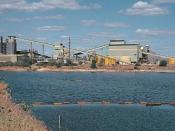It All started on June 28th when the united steelworker's representatives left the negotiation table after three days of agonizing discussions. The right to vote was valid upon June 29th 2004, but the strike actually only started on July 19th, 2004. The Labrador City and Sept-Iles mines summed up to a grand total 1400, where 280 are united workers from Sept-Iles and close to a thousand work at the Labrador City mine. The final offer presented to the board of representatives, proposed a 2 $ and 2,40 $ wage increase for the Sept-Iles and Labrador City mines, following was a 3 year salary freeze, and finally was the implementation of the all new evaluation job performance. For reasons to be later discussed 95% of Sept-Iles and 99% of Labrador City's miners rejected the last offers made by the I.O.C.
Rio Tintos branch in Australia has had though moments implementing their new job evaluation performance.
The Australian commission of industrial relations has ordered I.O.C to reinstate 178 employees fired due to mischief. Officials referred to it as unjust. Legal claims settled by a 25 million dollar law suit as compensation to the 178 employees mistreated. Meanwhile, this same job evaluation performance was trying to be implemented in Sept- Isles and Labrador City. Managers at I.O.C. were once particularly appealed to this evaluation job performance due to its focus on teamwork, safety, and high commitment. In addition, the employees who lack certain attributes will now be able to be trained by a whole new training system.
In 2004, Canada`s branch of I.O.C, generated 13 million dollar of profit, which were in part due to the increasing price of iron, and the decreasing operation costs. On the other hand, other Rio Tinto affiliations have submitted much greater profit, including Australia's Hamersley...


